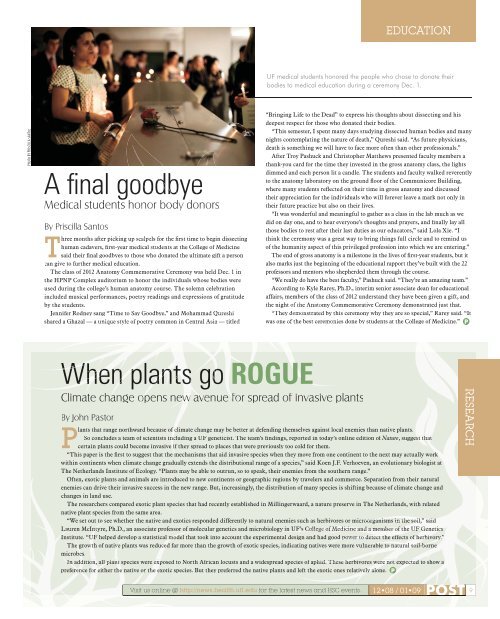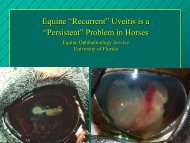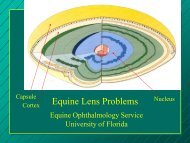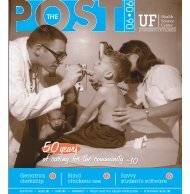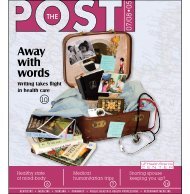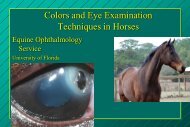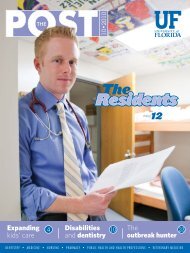DISSECTING - UF Health Podcasts
DISSECTING - UF Health Podcasts
DISSECTING - UF Health Podcasts
- No tags were found...
You also want an ePaper? Increase the reach of your titles
YUMPU automatically turns print PDFs into web optimized ePapers that Google loves.
EDUCATION<strong>UF</strong> medical students honored the people who chose to donate theirbodies to medical education during a ceremony Dec. 1.PHOTO BY PRISCILLA SANTOSA final goodbyeMedical students honor body donorsBy Priscilla SantosThree months after picking up scalpels for the first time to begin dissectinghuman cadavers, first-year medical students at the College of Medicinesaid their final goodbyes to those who donatedthe ultimate gift a personcan give to further medical education.The class of 2012 Anatomy Commemorative Ceremonywas held Dec. 1 inthe HPNP Complex auditorium to honor the individuals whose bodies wereused during the college’s human anatomy course. The solemncelebrationincluded musical performances, poetry readings and expressions of gratitudeby the students.Jennifer Rodney sang “Time to Say Goodbye,” and Mohammad Qureshishared a Ghazal — a unique style of poetry common in Central Asia — titled“Bringing Life to the Dead” to express his thoughts about dissecting and hisdeepest respect for those who donated their bodies.“This semester, I spent many days studying dissected human bodies and manynights contemplating the nature of death,” Qureshi said. “As future physicians,death is something we will have to face more often than other professionals.”After Troy Pashuck and Christopher Matthews presented faculty members athank-you card for the time they invested in the gross anatomy class, the lightsdimmed and each person lit a candle. The students and faculty walked reverentlyto the anatomy laboratory on the ground floor of the Communicore Building,where many students reflected on their time in gross anatomy and discussedtheir appreciation for the individuals who will forever leave a mark not only intheir future practice but also on their lives.“It was wonderful and meaningful to gather as a class in the lab much as wedid on day one, and to hear everyone’s thoughts and prayers, and finally lay allthose bodies to rest after their last duties as our educators,” said Lola Xie. “Ithink the ceremony was a great way to bring things full circle and to remind usof the humanity aspect of this privileged profession into which we are entering.”The end of gross anatomy is a milestone in the lives of first-year students, but italso marks just the beginning of the educational rapport they’ve built with the 22professors and mentors who shepherded them through the course.“We really do have the best faculty,” Pashuck said. “They’re an amazing team.”According to Kyle Rarey, Ph.D., interim senior associate dean for educationalaffairs, members of the class of 2012 understand they have been given a gift, andthe night of the Anatomy Commemorative Ceremony demonstrated just that.“They demonstrated by this ceremony why they are so special,” Rarey said. “Itwas one of the best ceremonies done by students at the College of Medicine.” PWhen plants go ROGUEClimate change opens new avenue for spread of invasive plantsBy John PastorPlants that range northward because of climate change may be better at defending themselves against local enemies than native plants.So concludes a team of scientists including a <strong>UF</strong> geneticist. The team’s findings, reported in today’s online edition of Nature, suggest st thatcertain plants could become invasive if they spread to places that were previously too cold for them.“This paper is the first to suggest that the mechanisms that aid invasive species when they move from one continent to the next may actually workwithin continents when climate change gradually extends the distributional range of a species,” said Koen J.F. Verhoeven, an evolutionary biologist atThe Netherlands Institute of Ecology. “Plants may be able to outrun, so to speak, their enemies from the southern range.”Often, exotic plants and animals are introduced to new continents or geographic regions by travelers and commerce. Separation from their naturalenemies can drive their invasive success in the new range. But, increasingly, the distribution of many species is shifting because of climate change andchanges in land use.The researchers compared exotic plant species that had recently established in Millingerwaard, a nature preserve in The Netherlands, with relatednative plant species from the same area.“We set out to see whether the native and exotics responded differently to natural enemies such as herbivores or microorganisms in the soil,” saidLauren McIntyre, Ph.D., an associate professor of molecular genetics and microbiology ogy in <strong>UF</strong>’s College of Medicine dicineandamemberoftha the <strong>UF</strong> GeneticsInstitute. “<strong>UF</strong> helped develop a statistical model that took into account the experimental design and had good power to detect the effects of herbivory.”The growth of native plants was reduced far more than the growth of exotic species, indicating natives were more vulnerable to natural soil-bornemicrobes.In addition, all plant species were exposed to North African locusts and a widespread species of aphid. These herbivores were not expected to show apreference rence for either the native or the exotic species. But they preferred the native plants and left the exotic ones relatively alone.PVisit us online @ http://news.health.ufl.edu for the latest news and HSC events. 12•08 / 01•09POSTRESEARCH9


